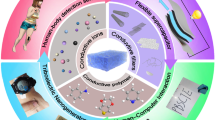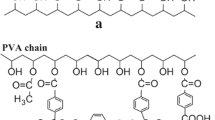Abstract
PVC materials grafted with ricinoleic acid-derived phosphate ester (PVC-AR-g, g = 1 ~ 4, where ricinoleic acid-derived phosphate ester grafts are abbreviated as AR) were prepared via a green and effective synthetic method. These materials were developed with the aim of overcoming the toxicity limits and environmental pollution issues caused by toxic dioctyl phthalate, which is traditionally used for plasticizing PVC materials. In this study, 3-aminopropyltri ethoxysilane (APTES) and AR, which contains phosphate ester groups, hydroxyl groups, linear alkyl groups, highly flexible long carbon chains and siloxane were introduced into the chains of PVC to efficiently plasticize PVC materials. Dynamic mechanical analysis (DMA) and differential scanning calorimetry (DSC) were used to investigate the mechanical and plasticization properties, respectively, of the plasticized PVC films. Meanwhile, the leaching properties were also examined. The good plasticization behavior of the PVC-AR-g materials was attributed to the numerous hydroxyl, ester, linear siloxane and highly flexible long carbon chain present simultaneously in the branched segments, which formed strong hydrogen bonding and dipole–dipole interactions with the PVC main chains. Moreover, the PVC-AR-g materials showed improved thermal stability and outstanding anti-migration ability because of the covalent bonds between the PVC and graft intermediate.










Similar content being viewed by others
References
Acres RG, Ellis AV, Alvino J, Lenahan CE, Khodakov DA, Metha GF, Andersson GG (2012) Molecular structure of 3-aminopropyltriethoxysilane layers formed on silanol-terminated silicon surfaces. J Phys Chem C 116:6289–6297
Adams A, Kwamen R, Woldt B, Grass M (2015) Nondestructive quantification of local plasticizer concentration in PVC by 1H NMR relaxometry. Macromol Rapid Commun 36:2171–2175
Becerra A, Rodríguez-Llamazares S, Carrasco C, Díaz-Visurraga J, Riffo C, Mondaca MA (2012) Preparation of poly(vinyl chloride)/copper nanocomposite films with reduced bacterial adhesion. High Perform Polym 25:51–60
Bocqué M, Lapinte V, Courault V, Couve J, Cassagnau P, Robin JJ (2018) Phosphonated lipids as primary plasticizers for PVC with improved flame retardancy. Eur J Lipid Sci Technol 120:1800062
Bueno-Ferrer C, Garrigós MC, Jiménez A (2010) Characterization and thermal stability of poly(vinyl chloride) plasticized with epoxidized soybean oil for food packaging. Polym Degrad Stab 95:2207–2212
Cheng SJ, Beyer FL, Mather BD, Moore RB, Long TE (2011) Phosphonium-containing ABA triblock copolymers: controlled free radical polymerization of phosphonium ionic liquids. Macromol 44:6509–6517
Cui HY, Zhang CH, Li CZ, Lin L (2020) Inhibition of escherichia coli O157:H7 biofilm on vegetable surface by solid liposomes of clove oil. Lwt-Food Sci Technol 117:108656
Earla A, Braslau R (2014) Covalently linked plasticizers: triazole analogues of phthalate plasticizers prepared by mild copper-free “click” reactions with azide-functionalized PVC. Macromol Rapid Commun 35:666–671
Hoque B, Almeida MIGS, Cattrall RW, Gopakumar TG, Kolev SD (2021) Improving the extraction performance of polymer inclusion membranes by cross-linking their polymeric backbone. React Funct Polym 160:104813
Jia PY, Hu LH, Shang QQ, Wang R, Zhang M, Zhou YH (2017) Self-plasticization of PVC materials via chemical modification of mannich base of cardanol butyl ether. ACS Sustainable Chem Eng 5:6665–6673
Jia PY, Ma Y, Kong Q, Xu L, Hu Y, Hu L, Zhou Y (2019a) Graft modification of polyvinyl chloride with epoxidized biomass-based monomers for preparing flexible polyvinyl chloride materials without plasticizer migration. Mater Today Chem 13:49–58
Jia PY, Ma YF, Song F, Hu Y, Zhang CQ, Zhou YH (2019b) Toxic phthalate-free and highly plasticized polyvinyl chloride materials from non-timber forest resources in plantation. React Funct Polym 144:104363
Jia PY, Ma YF, Song F, Liu CG, Hu LH, Zhou YH (2021) Renewable atom-efficient dendrimer-like acetate: from toxic tung oil to non-toxic plasticizers. Mater Today Chem 21:100518
Lafarge J, Kébir N, Schapman D, Burel F (2013) Design of self-disinfecting PVC surfaces using the click chemistry. React Funct Polym 73:1464–1472
Lee KW, Chung JW, Kwak SY (2016) Structurally enhanced self-plasticization of poly(vinyl chloride) via click grafting of hyperbranched polyglycerol. Macromol Rapid Commun 37:2045–2051
Lei YC, Xiao CW, Wang X, Yue JJ, Zhu Q (2015) Tensile properties and fracturing behavior of weld joints in the CLAM at high temperatures. Fusion Eng Des 95:27–33
Li YH, Qiu FX, Yang DY, Sun P, Li XH (2012) Transesterification of soybean oil and analysis of bioproduct. Food Bioprod Process 90:135–140
Liu HX, Jiang YJ, Tan WS, Chen GC, Liu W, Wang X (2017) The study of laser transmission joining PA66 and PVC with large compatibility difference. J Manuf Processes 26:252–261
Ma YF, Liao SL, Li QG, Guan Q, Jia PY, Zhou YH (2020) Physical and chemical modifications of poly(vinyl chloride) materials to prevent plasticizer migration - Still on the run. React Funct Polym 147:104458
Ma YF, Song F, Hu Y, Kong QY, Liu CG, Rahman MA, Zhou YH, Jia PY (2020) Highly branched and nontoxic plasticizers based on natural cashew shell oil by a facile and sustainable way. J Cleaner Prod 252:119597
Navarro R, Perrino PM, García C, Elvira C, Gallardo A, Reinecke H (2016) Highly flexible PVC materials without plasticizer migration as obtained by efficient one-pot procedure using trichlorotriazine chemistry. Macromol 49:2224–2227
Rispoli AL, Verdone N, Vilardi G (2021) Green fuel production by coupling plastic waste oxy-combustion and PtG technologies: Economic, energy, exergy and CO2-cycle analysis. Fuel Process Technol 221:106922
Vilardi G, Bassano C, Deiana P, Verdone N (2020) Exergy and energy analysis of three biogas upgrading processes. Energy Convers Manage 224:113323
Wang M, Jiang JC, Xia JL, Li SH, Li M (2018a) Phosphate ester groups-containing ricinoleic acid-based Ca/Zn: preparation and application as novel thermal stabilizer for PVC. J Appl Polym Sci 135:45940
Wang M, Kong XH, Song XH, Chen YL, Bu Q (2021) Construction of enhanced self-plasticized PVC via grafting with bio-derived mannich base. New J Chem 45:3441
Wang M, Song XH, Jiang JC, Xia JL, Ding HY, Li M (2018b) Plasticization and thermal behavior of hydroxyl and nitrogen rich group-containing tung-oil-based ester plasticizers for PVC. New J Chem 42:2422–2431
Wang M, Song XH, Jiang JC, Xia JL, Li M (2017) Binary amide-containing tung-oil-based Ca/Zn stabilizers: effects on thermal stability and plasticization performance of poly(vinyl chloride) and mechanism of thermal stabilization. Polym Degrad Stab 143:106–117
Wang M, Song XH, Jiang JC, Xia JL, Li M (2018c) Influence of zeolitic imidazolate framework-8 on the thermal stabilization of poly(vinyl chloride). Polym Degrad Stab 149:112–118
Yang J, Mao X, Du LR, Wu BZ, Zhang FF, Hu WC, Tang XZ (2017a) Thermally stabilized bismaleimide–triazine resin composites for 10-GHz level high-frequency application. High Perform Polym 30:833–839
Yang XJ, Wang CP, Li SH, Huang K, Li M, Mao W, Cao S, Xia JL (2017b) Study on the synthesis of bio-based epoxy curing agent derived from myrcene and castor oil and the properties of the cured products. RSC Adv 7:238–247
Yang XJ, Wang CP, Xia JL, Mao W, Li SH (2017c) Study on synthesis of novel phosphorus-containing flame retardant epoxy curing agents from renewable resources and the comprehensive properties of their combined cured products. Prog Org Coat 110:195–203
Zhang JJ, Zou XB, Zhai XD, Huang XW, Jiang CP, Holmes M (2019) Preparation of an intelligent pH film based on biodegradable polymers and roselle anthocyanins for monitoring pork freshness. Food Chem 272:306–312
Zhu YL, Li CZ, Cui HY, Lin L (2020) Feasibility of cold plasma for the control of biofilms in food industry. Trends Food Sci Technol 99:142–151
Acknowledgements
This study was financially offered by the Jiangsu Province Biomass Energy and Materials Laboratory (JSBEM201917) and the National Natural Science Foundation of China (21905117).
Author information
Authors and Affiliations
Corresponding authors
Ethics declarations
Conflict of interest
The author(s) declared no potential conflicts of interest with respect to the research, authorship and/or publication of this article.
Additional information
Publisher's Note
Springer Nature remains neutral with regard to jurisdictional claims in published maps and institutional affiliations.
Rights and permissions
About this article
Cite this article
Wang, M., Wang, G., Xu, Y. et al. Simultaneous improvement of the plasticization, mechanical and migration resistance properties of PVC materials by grafting ricinoleic acid-derived phosphate ester. Chem. Pap. 76, 351–359 (2022). https://doi.org/10.1007/s11696-021-01860-z
Received:
Accepted:
Published:
Issue Date:
DOI: https://doi.org/10.1007/s11696-021-01860-z




